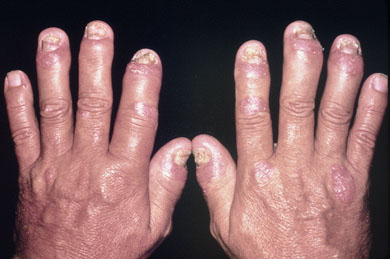Psoriatic arthritis, one of over 100 forms of arthritis, holds similarities to rheumatoid arthritis, though with milder symptoms. Psoriatic arthritis symptoms include both skin problems and joint damage. You cannot cure this chronic disease, but you can find many treatments—both medical and natural—available to alleviate symptoms. Psoriatic arthritis usually affects fingers and toes, sometimes the spine, and in rare cases other joints in the body. The skin problems most commonly affect the knees, scalp and elbows. Millions of Americans suffer from psoriatic arthritis.
1. Patients suffering from psoriatic arthritis should include exercise in their daily routine. Though psoriatic arthritis affects fewer joints in the body than other forms of arthritis, you must work all the joints on a regular basis to avoid future damage. Yoga, Pilates or Tai Chi can prove beneficial for patients with arthritis, increasing the mobility of the joints and reducing stiffness and pain.
2. Doctors recommend patients with arthritis undertake hydrotherapy, a form of physical therapy done in water. The water takes the pressure off joints and allows patients to move easily and without effort.
3. Psoriatic arthritis affects both the tissues in the joints and the skin tissue. Patients have to take care of their skin condition to avoid further damage to the muscle tissue.

4. Natural supplements prove effective when it comes to treating psoriatic arthritis. Look for supplements that contain glucosamine, flaxseed oil, fish oil, chondroitin, vitamin D and calcium. These nutrients fight inflammation in the joints and also help with psoriasis. Talk with your doctor before taking any supplements. Although usually risk free, some supplements might cause interactions between psoriatic arthritis medication and natural supplements.
5. Place hot compresses on inflamed joints and cold compresses on stiff joints. Hot and cold therapy can help reduce pain, inflammation and stiffness, especially when you combine it with different sets of exercises. Talk to a physical therapist to learn what exercises you can practice to treat symptoms of psoriatic arthritis.
6. Consider using acupuncture. Find a qualified acupuncturist and discuss a possible treatment plan. Acupuncture works very well for pain relief and will also boost your immune system, helping your body fight both the arthritis and the psoriasis.
7. Ask your acupuncturist or doctor about herbal teas you can drink for your condition. If you don’t have stomach problems, include cayenne pepper powder in your diet. One-half teaspoon of cayenne pepper powder a day reduces inflammation in the joints and relieves pain.
8. Massage painful joints with olive oil, a powerful natural remedy for many conditions. Olive oil will absorb in your skin and fight inflammation. You can also try compresses with apple cider vinegar. Mix one-half cup of organic apple cider vinegar with water and apply a warm compress on the affected joint. Apple cider vinegar is an acid, so make sure not to touch the skin portions affected by psoriasis.


